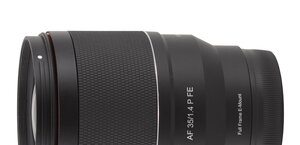Tokina AT-X DX AF 16.5-135 mm f/3.5-5.6
3. Build quality
 |
The dimensions of the Tokina increase when you change the focal length value. At the maximum focal length its height reaches already 14 cm. The front element extends on a metal telescopic inner barrel.
Please Support UsIf you enjoy our reviews and articles, and you want us to continue our work please, support our website by donating through PayPal. The funds are going to be used for paying our editorial team, renting servers, and equipping our testing studio; only that way we will be able to continue providing you interesting content for free. |
- - - - - - - - - - - - - - - - - - - - - - - - - - - - - - - - - - - - - - - - - - - - - - - -
The following chart allows us to compare the parameters of the Tokina and those of its several rivals. At some points the Tokina differs greatly from the rest – it has the worst minimum focus distance, which amounts to 0.5 m. Its front element is the biggest for a change, surrounded by a non- rotating filter thread with an impressing diameter of 77 mm. Apart from that, the Tokina’s aperture has the biggest number of diaphragm blades and the whole instrument is the heaviest.
Such a significant weight is undoubtedly caused by the presence of metal parts in the barrel. Tokina lenses have never featured a lot of plastic and the 16.5-135 mm model is not an exception to this rule. It starts with a metal mount and soon afterwards, on the left, we find a focusing mode switch (AF/MF). Next, we see a comfortable, ribbed zoom ring. Unfortunately it is not as well-damped as it should be. In the 16.5-20 mm range the resistance is appropriate so the front element in the folded position doesn’t extend under its own weight. From 20 mm to more or less 90 mm you can notice a significant backlash though. The ring turns very easily and the lens extends on its own when tilted from the vertical position. In the 90-135 mm range the resistance is once again right.
 |
Behind the zoom ring we see a plate with the name and the parameters of the lens; above it we have a manual focus ring. It is quite big and comfortably ribbed, featuring a distance scale in feet and meters. Unfortunately it is not very precise and it can be connected with the fact that running through the scale requires just a 40-degree turn. As a result, a slight move of the ring causes a big leap in distance (and sharpness).
When it comes to the inner design, we deal here with 15 elements in 12 groups. As many as three elements are aspherical and two others were made of low-dispersion SD glass. Inside the lens we find also a circular aperture with nine diaphragm blades which, depending on the focal length, can be closed down to f/22 at the widest angle and to f/36 at 135 mm.
 |
The buyer gets both caps and a petal-type lens hood included in box.
 |






